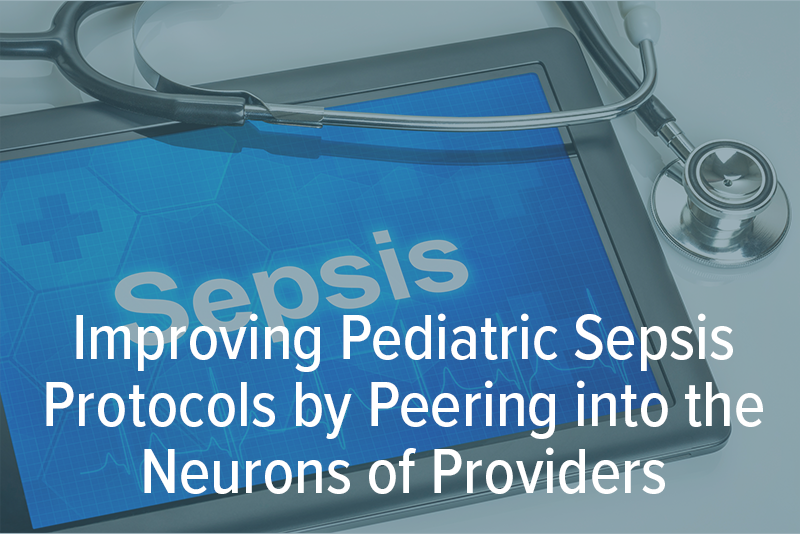

Matthew J. Hays, PhD
Senior Director of Research and Analytics
Sepsis is the leading cause of death in children worldwide, with mortality rates between 4% and 20% in different pediatric populations and settings. When sepsis has become severe, death becomes 8% more likely for every hour that antibiotics are delayed. Timely diagnosis and treatment are the difference between life and death.
In response, Children’s Hospital Colorado (CHCO) has spearheaded a sepsis quality improvement initiative focused on improving early detection and effective management of sepsis. The goal was to use training to support clinicians’ quick, confident, and correct decision-making when pediatric sepsis is or should be suspected. The details of this endeavor were published in the latest edition of Pediatric Quality & Safety.
In the article, CHCO physicians Justin Lockwood and collaborators describe the development of a new sepsis course. The course integrates current national guidelines as well as best practices developed at CHCO to improve the recognition and management of pediatric sepsis. This course was jointly developed by sepsis experts at CHCO and the Amplifire Healthcare Alliance (AHA), a federation of top health systems working together to improve care and reduce harm.
The course was then deployed through Amplifire’s adaptive e-learning platform to frontline personnel. CHCO chose to partner with Amplifire on this effort for two reasons. First, Amplifire training has been shown to improve patient care and clinical outcomes. Second, Amplifire is built to detect when providers are sure that their knowledge is accurate or their decisions are sound—but they’re actually wrong. This confidently held misinformation (CHM) directly leads to missed diagnoses and even patient harm. “Amplifire introduced us to the concept of confidently held misinformation,” said Dr. Dan Hyman, CHCO’s Chief Medical and Patient Safety Officer.
Adaptive E-Learning
Amplifire’s training software is able to have clinical impacts because it is designed entirely around how we learn and remember. The Amplifire experience begins with questions about the learning objectives. Amplifire takes this question-first approach because well-designed questions can prepare the brain to learn. Many of the questions are asked in a multiple-choice format, which has been shown to improve the transfer of training beyond a single item’s learning objective.
When responding to questions in Amplifire, learners indicate the answer(s) they believe to be correct as well as their confidence in their decision, a patented process that improves long term memory for the material.

Learners receive immediate feedback on whether their response was accurate and how their confidence was calibrated (e.g., “you were partially sure and one of your answers was correct.”). When a learner confidently answers a question correctly, corrective feedback is withheld; learners’ time is better spent on more productive activities. On the other hand, low-confidence correct answers and incorrect answers (especially in cases of CHM) are accompanied by delayed corrective feedback, which has been shown to differentially enhance learning.
The result is training that has unprecedented impacts on outcomes. One AHA member reported a 32% reduction in CAUTI when nurses were trained with Amplifire. In another study, Amped nurses reduced CLABSI by 48%. Current investigations suggest that Amplifire helps providers reduce sepsis mortality rates, prevent pressure injuries and patient falls, and reduce surgical-site and C. diff infections.
Findings and Implications
At the time of publication, a total of 1,129 CHCO providers had used Amplifire; over 300 more have since completed training. Amplifire’s flexible, modular approach to content enabled CHCO to train RNs, MDs, and APPs in non-ICU inpatient and ED settings.
The average learner took 27 minutes to complete the training. Some of the component items were basic tests of knowledge. Others presented interactive cases and scenarios that required learners to judge the best course of action. In all cases, the Amplifire platform tracked CHM as well as when learners struggled to overcome a stubborn misconception. This information can be reviewed visually in the heatmaps below.

Amplifire’s heatmaps can depict different aggregations of learners (e.g., by manager, department, shift) and content (e.g., by topic). Operational issues can quickly emerge; perhaps everyone who works for Chris shares the same misconception, or all nurses in a particular wing struggle with a particular procedure. Administrators can then evaluate and remedy these problems. According to Dr. Hyman, the heatmaps pinpoint exactly where “and how much work we have yet to do.”
Dr. Lockwood summarized Amplifire’s dual capabilities by saying that “the use of confidence-weighted testing allowed us to provide needed education to frontline clinicians while simultaneously identifying areas of risk for ongoing sepsis improvement. In this way, the impact and sustainability of our educational intervention was improved.”
Efforts are currently underway at CHCO to use Amplifire in other patient-care quality improvement initiatives. For a full list of available Amplifire courses, click here. To see their impacts on clinical and performance outcomes, see Amplifire’s case studies. To learn more about the Amplifire Healthcare Alliance, which includes systems like CHCO, Partners Health, Intermountain Health, Banner Health, and more, click here.
Reference: “Is this Sepsis?” Education: Leveraging Confidently Held Misinformation and Learner Struggle







